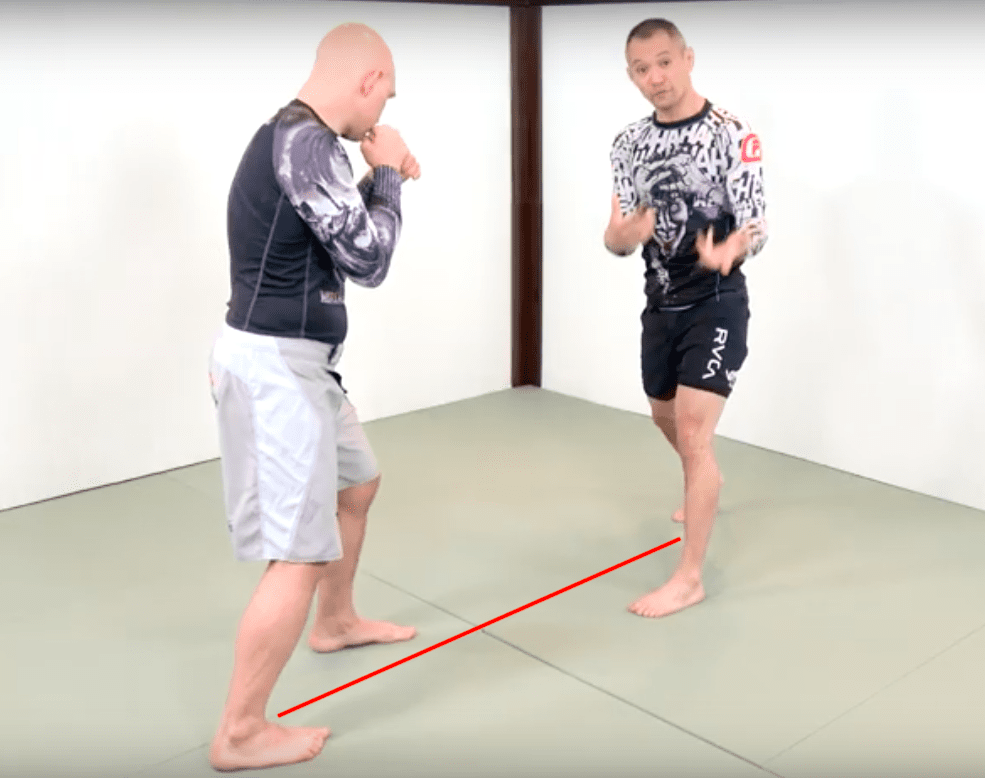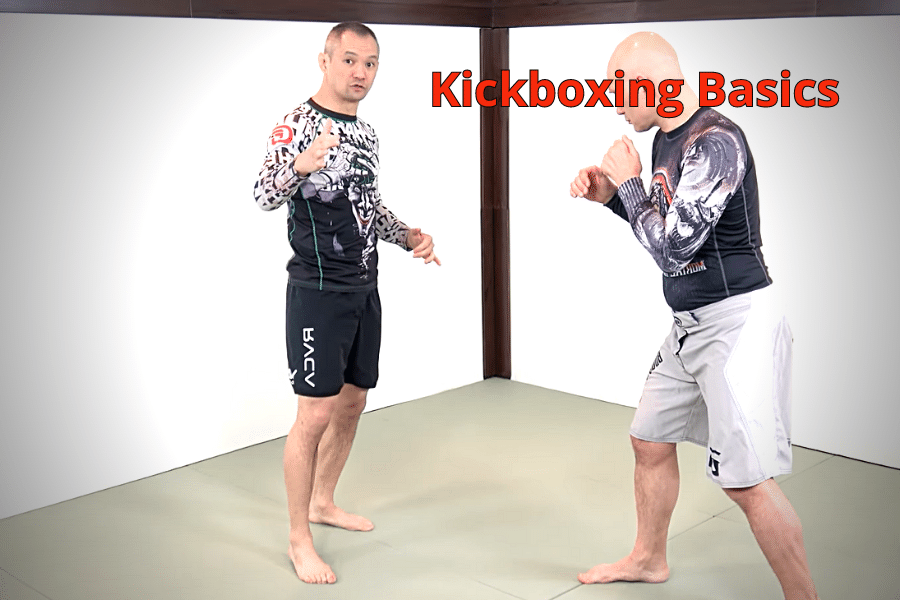
Table of Contents
Here’s a quick Kickboxing basics reference guide with all the punches and kicks you’ll be learning as an absolute beginner to Kickboxing.
Let’s start things off with how you should stand and fight.
Fight Stance
When it comes to Kickboxing basics, everything starts off with understanding who to effectively stand and fight. There’s a wide range of variations on fight stances. It seems like every Kickboxing coach on the planet has a different opinion on the perfect fight stance. So we’re going to keep things are simple as possible.
The first thing you also want to consider is that you always want to protect your neck.
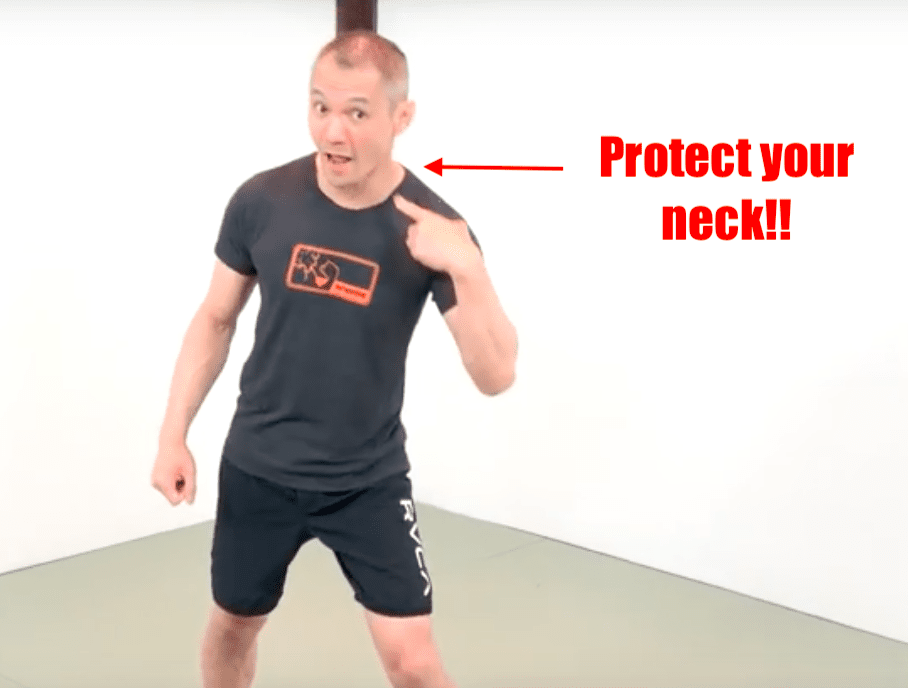
You always want to protect your neck. You can be tough. And maybe you can take a hard punch. But there’s no way you can take a punch to the neck. So, by focusing on protecting your neck, you’ll immediately want to drop your chin down, shrug your shoulders forward and keep your hands up. And thus, you’ll have the perfect fight stance just by focusing on protecting your neck.
In addition to protecting your neck, you also want to stand in an athletic position. You want to stand in what we call the “Universal Athletic Position”. This is the position that almost all athletes go into when they need to move quickly. Basically, the Universal Athletic Position is when you’re on your toes, your hips are low and your knees are bent.
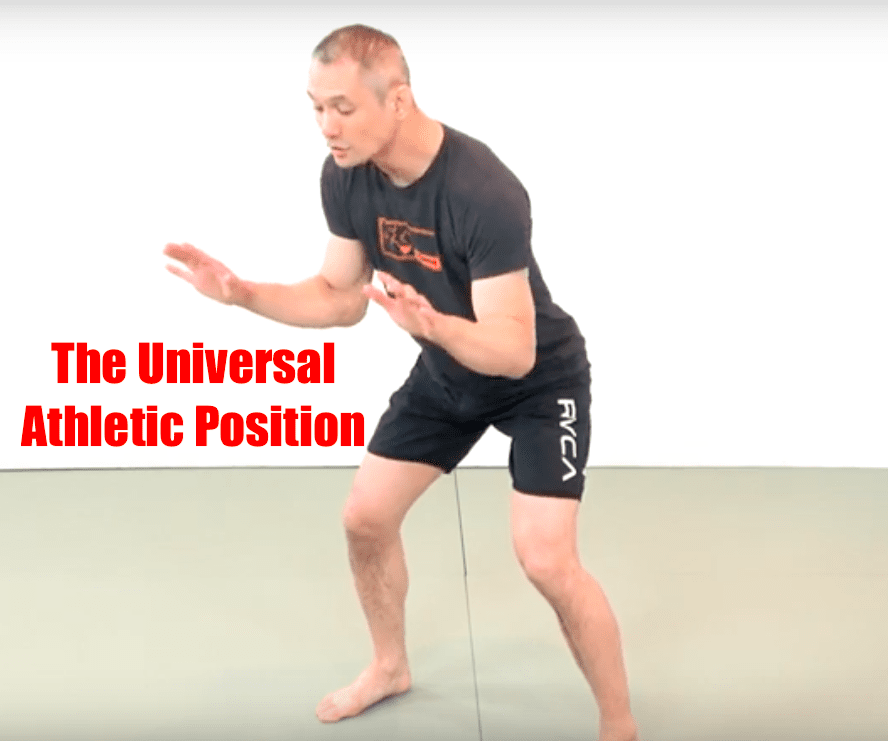
For Kickboxing, the only thing we want to change is the angle of our body. We just need to turn a little bit so we’re not completely square to our partner.
Watch 👀 the video 📺 below ⬇️
This video breaks down 3 common mistakes with the fighting stance that students make when they first start Kickboxing.
- Failing to protecting your neck
- Too stiff
- Not adapting
Punches
For the next section of Kickboxing Basics, let’s look at the different punches.
The Jab
The Jab is the first punch that every Kickboxing beginner should learn. And in sparring, the Jab is the most critical punch. With the Jab, you are not just trying to punch your partner in the nose. You’re using your Jab, to set up your additional punches. You are also using your Jab to establish and maintain the proper distance.
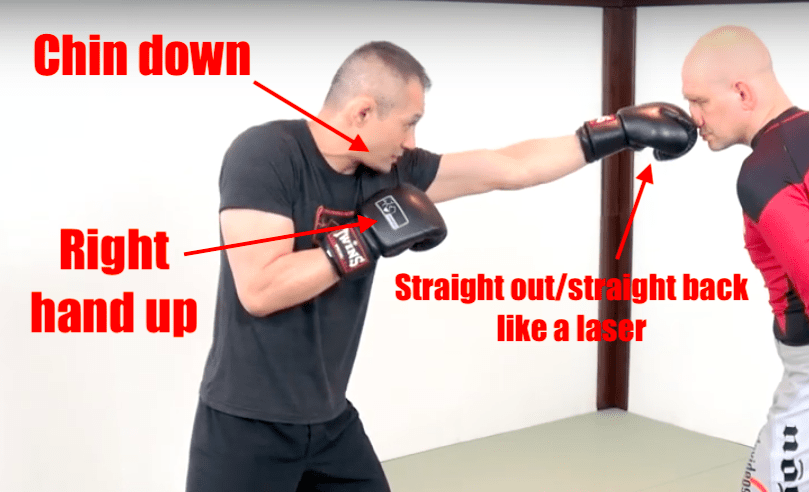
When you’re throwing your Jab, make sure you’re always protecting your neck. So this means keeping your chin down and your right hand up.
Also, when you’re throwing your Jab, it’s critical that your left fist goes straight out and comes straight back like a laser beam.
Furthermore, you want to focus on keeping your elbow in as much as you can when you’re throwing your Jab. Doing this will make your Jab more difficult to see. Check out the images below.
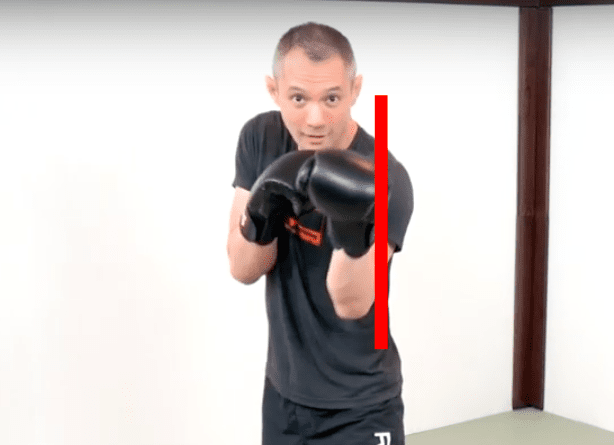
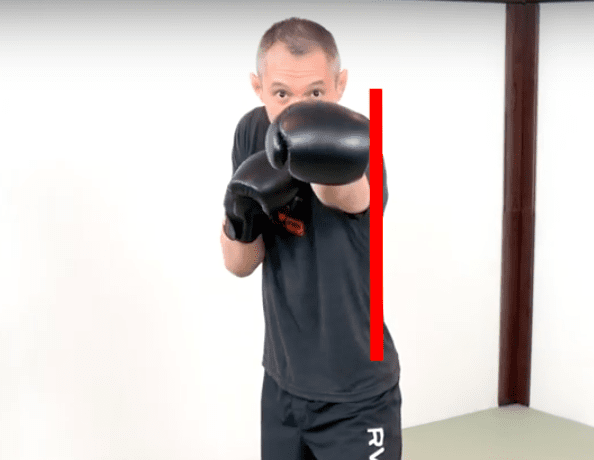
When you’re throwing your Jab, you want to keep your elbow in as much as you can. It’ll feel awkward at first, but with practice, it’ll be second nature to you. 😊
Watch 👀 the video 📺 below! ⬇️
In the video, I break down the 3 most common mistakes that Kickboxing beginners make with the Jab. Make sure you side step these mistakes when you’re practicing.
Key points to remember:
- Telegraphing the Jab
- Chin is up
- Elbow is up
The Straight Right
Let’s take a look at the Straight Right Hand. Sometimes it’s called a Cross. It’s when your right fist goes straight to your partner’s face. The punch is powered by the rotation of your shoulders and hips.
When you’re throwing your Straight Right Hand, make sure you have your chin down, your left hand up. And you’re turning your right foot so you can turn your hip for maximum power.
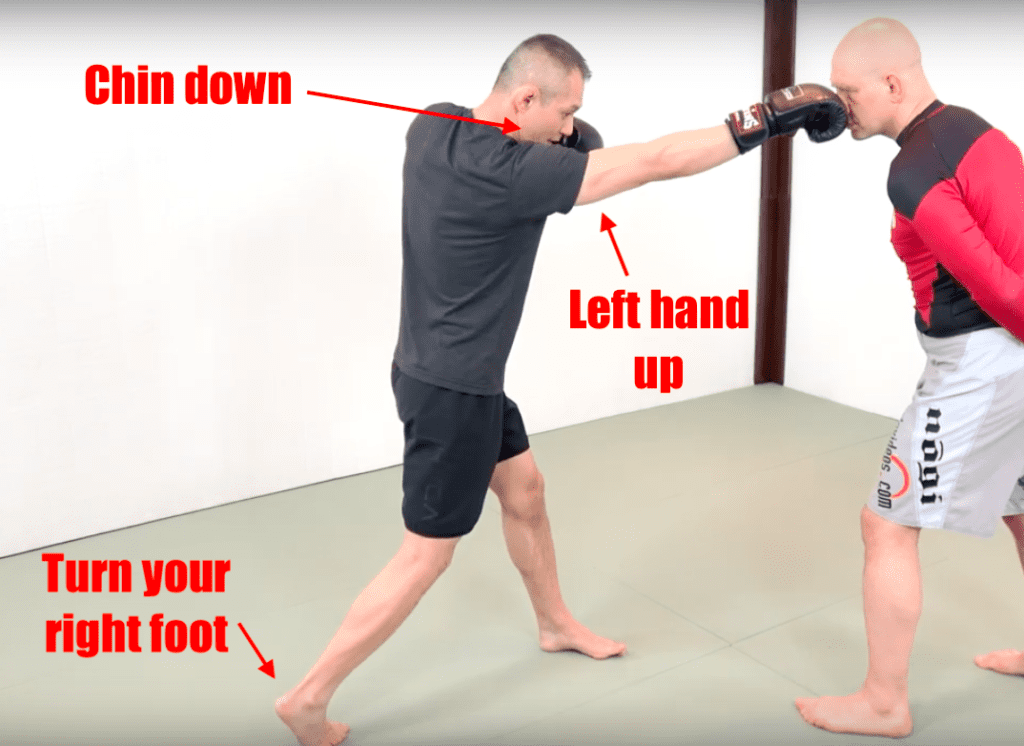
In addition, you need to make sure you keep your elbow in when you’re throwing your Straight Right Hand. A quick tip: try practicing your Straight Right Hand against a wall. This way, you have to keep your elbow in as you’re punching; otherwise, your elbow will run into the wall.
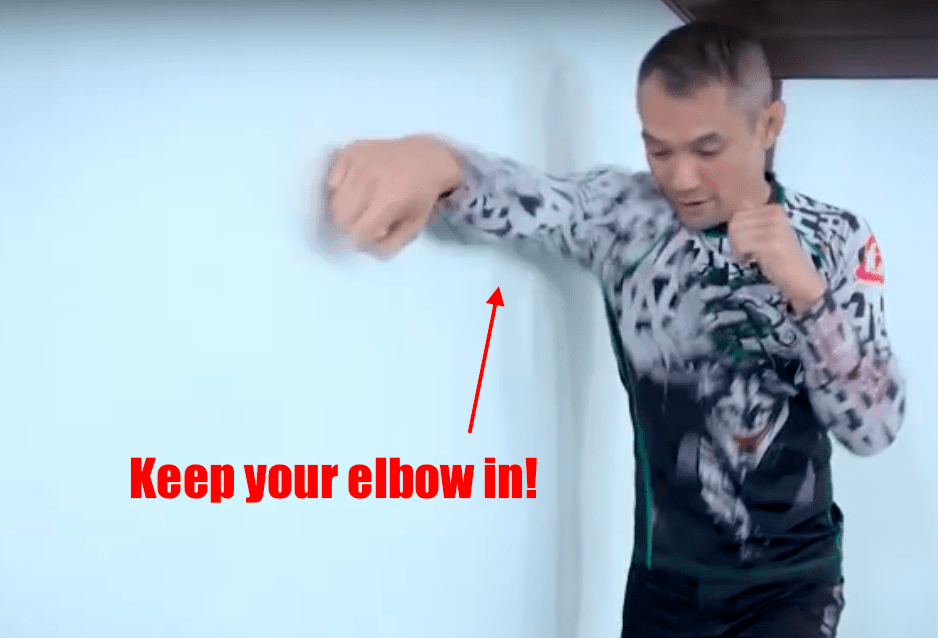
Also, keep in mind that you always want to stay in balance as you throw your Straight Right Hand.
Below is footage of me holding pads for one of my students, Ian Popoff.
Note how he’s always in balance. A common mistake is to lean too far forward when you’re throwing your Straight Right Hand. And thus, you’ll be wide open for counter attacks if your Right Hand doesn’t land.
Watch 👀 the video 📺 below! ⬇️
Be sure to hit play on my video below. This is where I breakdown 3 common mistakes with the Straight Right Hand. Keep these mistakes in mind when you’re training.
Points to remember:
- Chin is up
- Being off balance
- Elbow is up
Hooks
Perfecting your form for throwing Hooks is a critical components in your Kickboxing basics. Hooks are punches thrown to the side of your partner’s head. Hooks can also be thrown to your partner’s ribs.
As always, you want to protect your jaw. So when you’re throwing your Hook, make sure that your chin is down. Not only is your jaw protected by your shoulder, it’s protected by your other hand as well. For example, if I’m throwing a Left Hook, my left shoulder protects the left side of my jaw; plus, my right hand protects the right side of my jaw.
As well, don’t forget to keep your elbow in so your ribs are protected. Your partner is looking to counter punch you in the ribs with his left hook so make sure your right elbow is covered tight against your torso.
In order to produce maximum force for your Hooks, make sure your elbow is up to the same height as your fist. Meaning, if you’re throwing a Right Hook, your right elbow should be up as well.
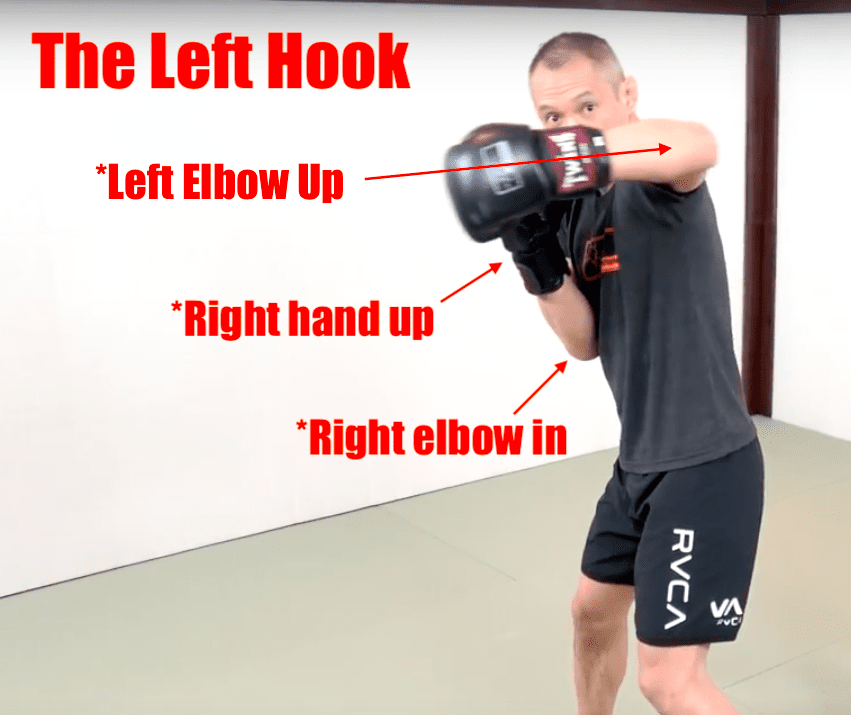
In addition to having your elbow up to maximize power for your Hooks, it’s critical for you to turn your heel. You’re turning your heels so you can follow through with your hips and your shoulders to power your hook. For example, if you’re throwing a right hook, be sure to turn your right heel.
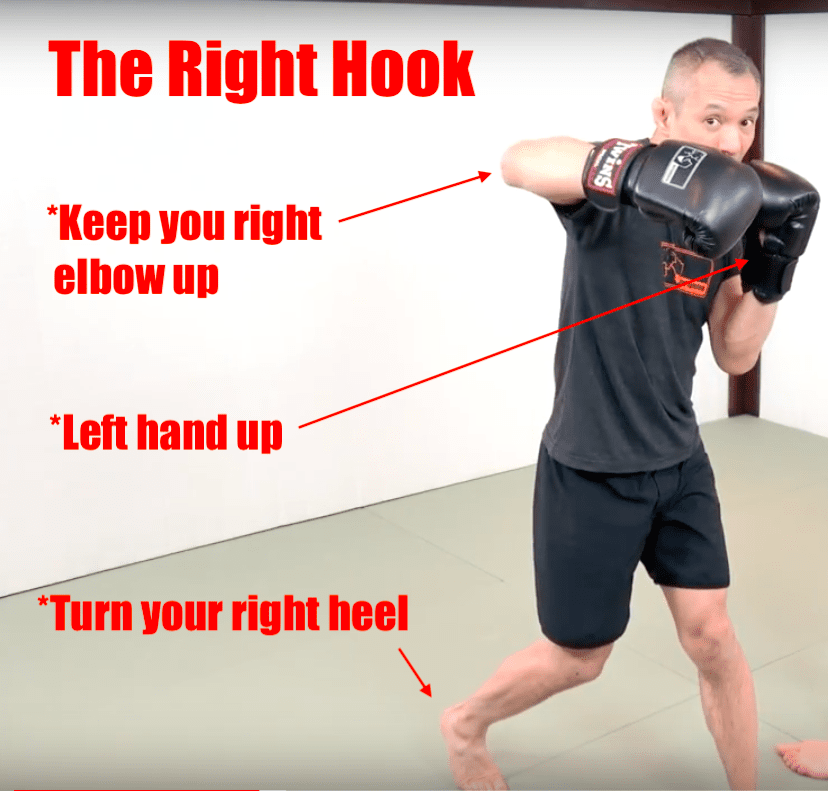
Watch 👀 the video 📺 below! ⬇️
This video is a quick breakdown of some of the common mistakes people make then they’re punching with Hooks. Pay attention to these mistakes as you could be making them yourself!
Points to remember:
- Leading with the shoulder
- Elbow is too low
- Not transferring your weight
Uppercuts
Think of the Uppercut like a Hook except instead of the punch being horizontal it’s now vertical.
You want to turn your shoulders so that your shoulders are almost vertical. Meaning, if you’re throwing a Left Uppercut, drop your left shoulder so you’ll have more power with the punch.
In addition, keep in mind that you need to protect against potential counter attacks from your partner. So keep your right hand up!
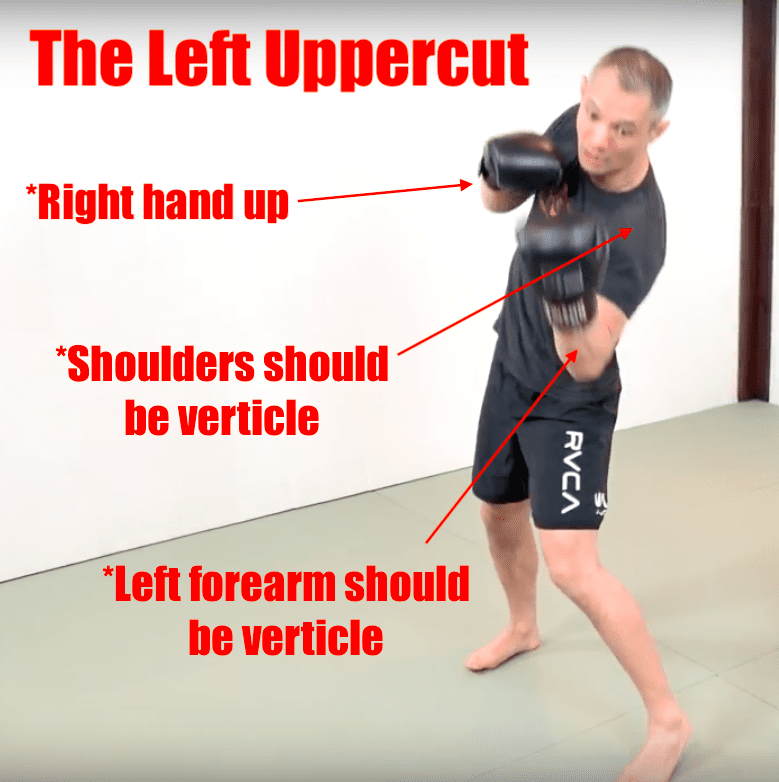
It should be noted that forearm should also be vertical for your Uppercuts. You’ll have great power and stability for your punch this way.
In addition to this, turn your heel so that you’re generating power through your hip for your Uppercuts.
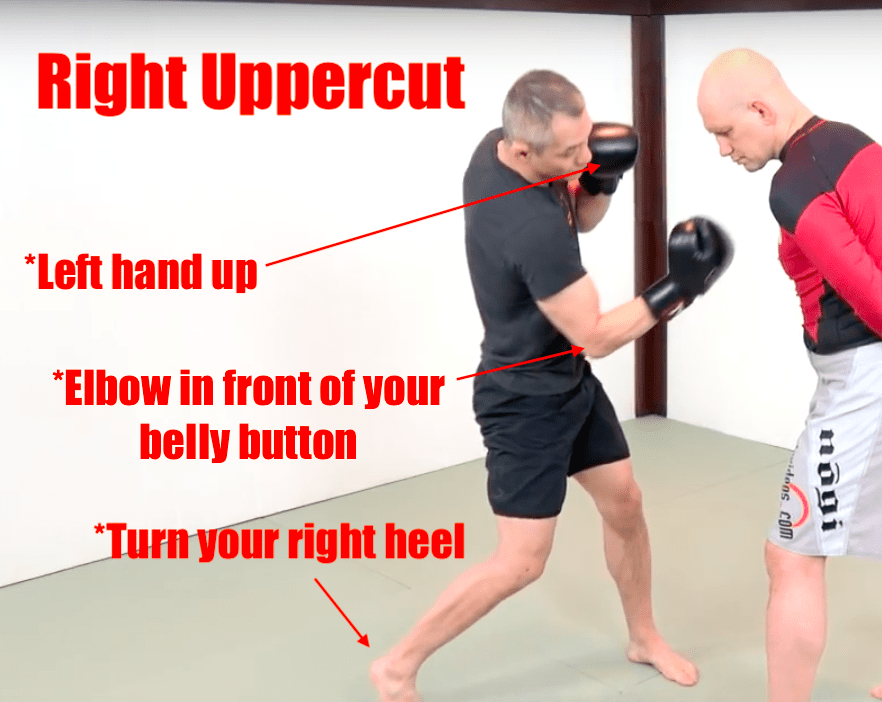
Watch 👀 the video 📺 below! ⬇️
This video breakdown is a summary of the common mistakes people make when they’re throwing the Uppercut. Make sure that you’re side stepping these mistakes as you’re training.
Points to remember:
- Dropping your hand
- Shoulders square to the floor
- Flaring up your opposite elbow
The Superman Punch
The Superman Punch is a cool attack that is set up with a fake right Kick that turns into a Straight Right Punch.
The first step in setting up your Superman Punch is to lift up your right knee. Your partner will think that you’re throwing a right Kick and they’ll drop their hands to defend.
Since your partner has dropped their hands to block your fake Kick, they’re now wide open for your Straight Right Punch.
Your right foot needs to stomp down so you’ll have proper foundation to power your Right Punch. In addition to that, you’ll also need to hop forward with your left foot.
Watch 👀 the video 📺 below! ⬇️
Here’s a quick video explaining how to throw the Superman Punch along with some common mistakes you need to avoid.
Points to remember:
- Keeping one foot up in the air
- Failing to have your foot on the ground
- Not hopping forward with your lead foot
Kicks
The Foot Jab
In terms of Kickboxing basics, the Foot Jab is a foundational Kick. The Foot Jab is simple and easy to learn. And it illustrates specific underlying principles for Kicking.
For all Kicks, you want to have your hands up and your elbows in. The Foot Jab is no different. You want to make sure that you’re protected against potential counter attacks from your opponent.
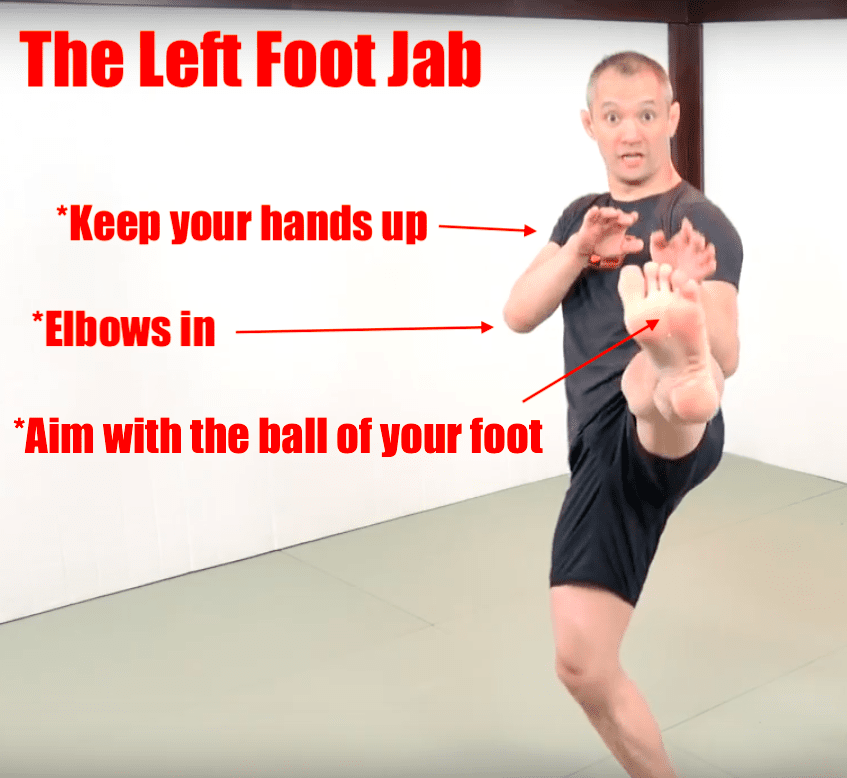
When you’re throwing your Foot Jab, keep in mind that you want to fully extend your kicking leg so that you maximize your distance and your reach.
It should also be noted that you want to lean back slightly at the moment of impact to help extend your Foot Jab even more.
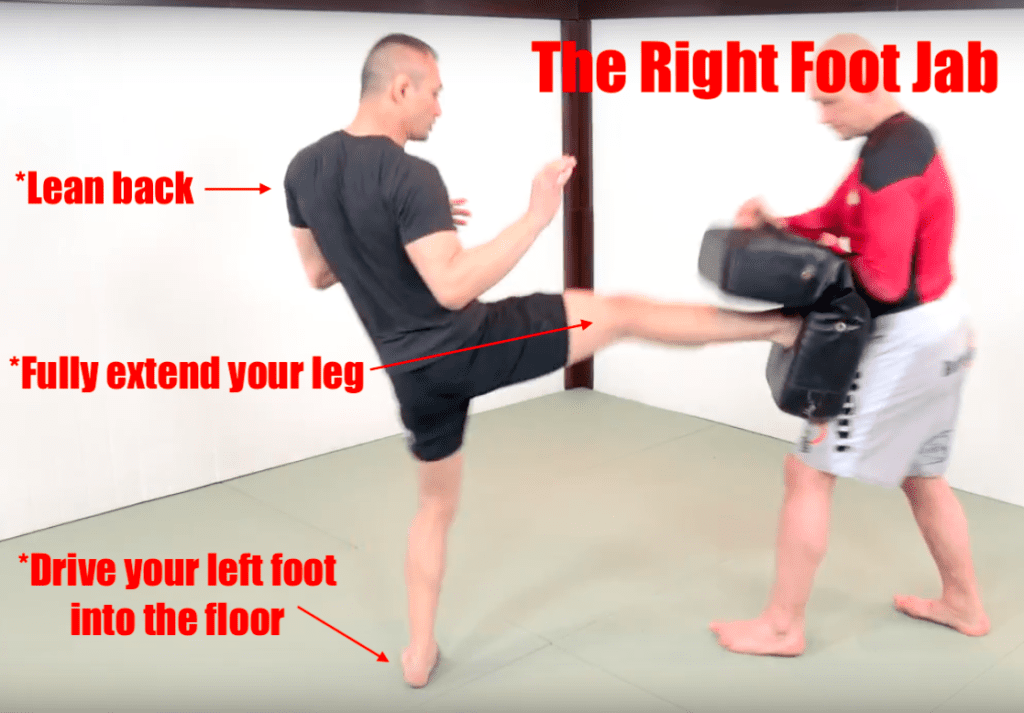
Especially important in maximizing the power of your Foot Jab is in the chambering and the lifting up of your knee. By lifting up your knee, you’ll have more power to stomp through your target.
Along with lifting up your knee, you want to ensure that your shin stays vertical throughout the path of your Kick. As a beginner in Kickboxing, one of the best ways to train this is up against a wall.
Watch 👀 the video 📺 below! ⬇️
Subsequently, all these tips on the Foot Jab are summarized in the video as I talk about the common mistakes people make they’re training this Kick.
Points to remember:
- Low knee
- Dropping your hands
- Lifting up your hands as a telegraph
The Hook Kick (Roundhouse Kick)
The Hook Kick, also know as the Roundhouse Kick, is a Kickboxing Basics cornerstone technique. It’s one of the first Kicks anyone should learn.
Think of the Hook Kick like a baseball bat that swings at your partners head, torso or leg.
Be sure to turn your left foot so that you’re generating power with your hip for your right kick.
Certainly, power is maximized when you’re leaning back so you can extend your kicking leg as much as possible.
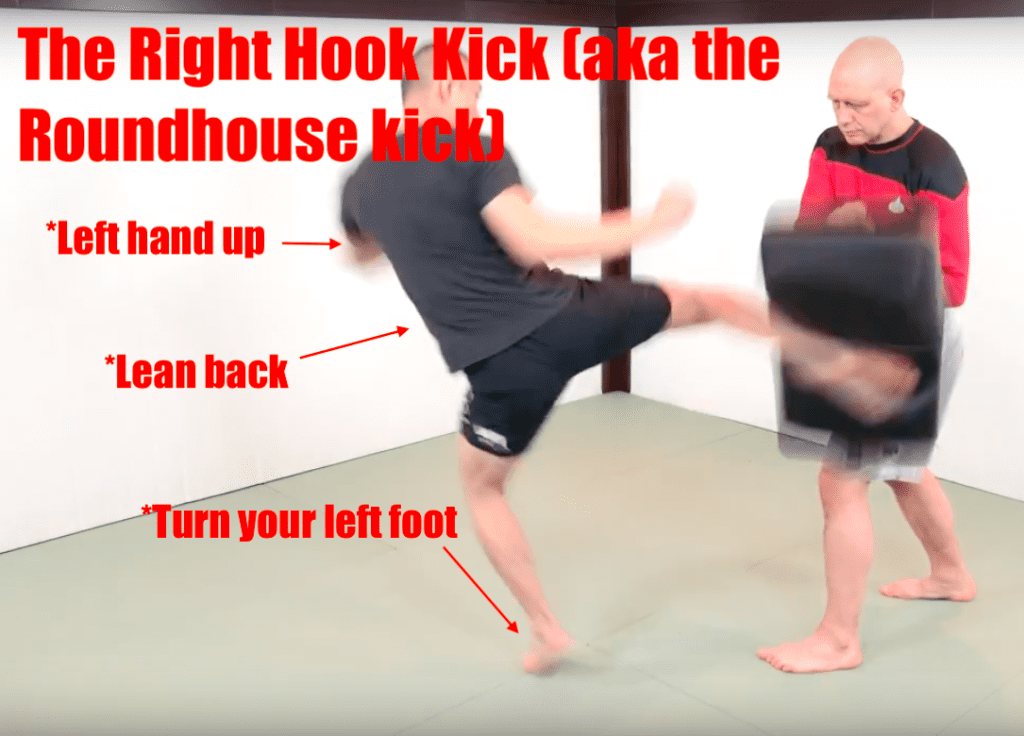
Undoubtedly, you always want to ensure that you’re safe from your partner’s counter attacks. Thus, you want to keep your left hand up with you’re kicking with your right leg. And alternately, you want to keep your right hand up when you’re kicking with your left leg.
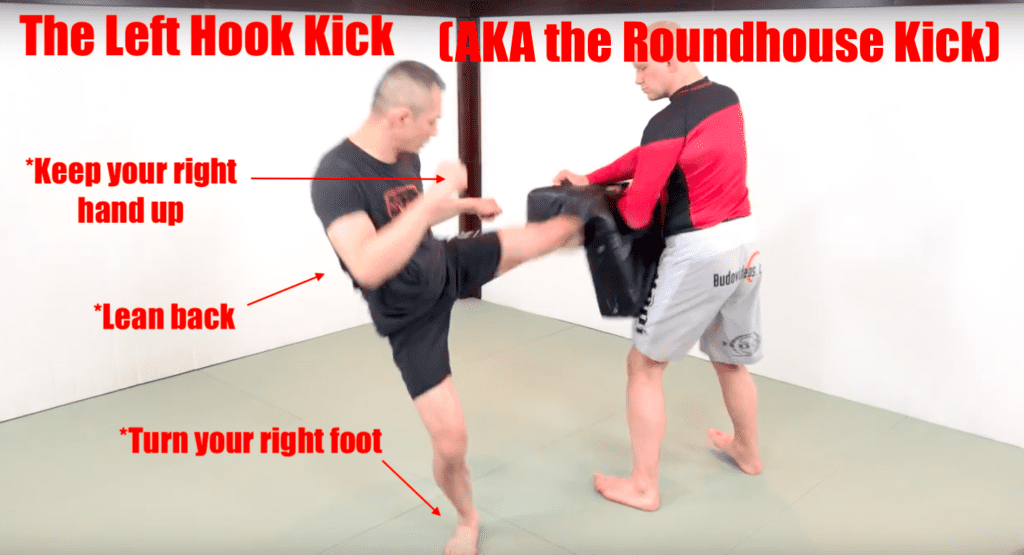
Subsequently, all these details for the Hook Kick fall smoothy into place with some practice. Below is some footage of me holding pads for my student, Ian Popoff. Note how he’s turning his left foot, keeping his left hand up and leaning back as he extends fully for his Right Hook Kick.
The Side Kick
The Side Kick is a fun Kick to learn, train and practice. It’s the Kick that you would use if you ever need to knock down a door 🤣
A fundamental detail when it comes to Kickboxing basics is that you want to kick the floor as you’re kicking your target. Basically, you want to have your feet as far apart as possible at the moment of impact for your all of your Kicks. This concept is illuminated clearly when you’re practicing the Side Kick.
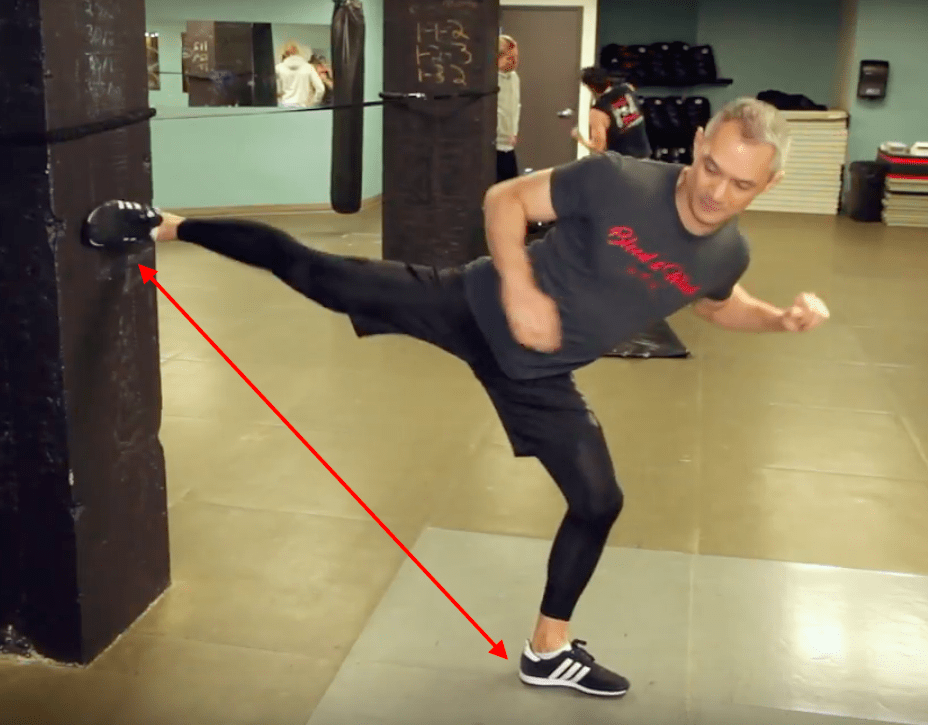
Without a doubt, chambering your knee is critical for developing maximum power for your Side Kick. You want to lift your knee up to your chest so you can stomp your foot into your target. Kicking over a stack of kicking shields forces you to chamber your knee.
Watch 👀 the video 📺 below! ⬇️
Check out this video tutorial on the Side Kick and the common mistakes related to it.
Points to remember:
- Not chambering your knee
- Aiming with your big toe
- Not pulling your toes
The Spinning Back Kick
Last but not least, the final technique for our Kickboxing basics is the Spinning Back Kick. Similar to the aforementioned Side Kick, the Spinning Back Kick just has a minor turn of the body first.
Above all, a successfully executed Spinning Back Kick, starts with understanding a little geometry. When we’re fighting, we share a line with our training partner.
And when we do our Spinning Back Kick, the first step is to walk across this line so we’re in proper position to hit our target.
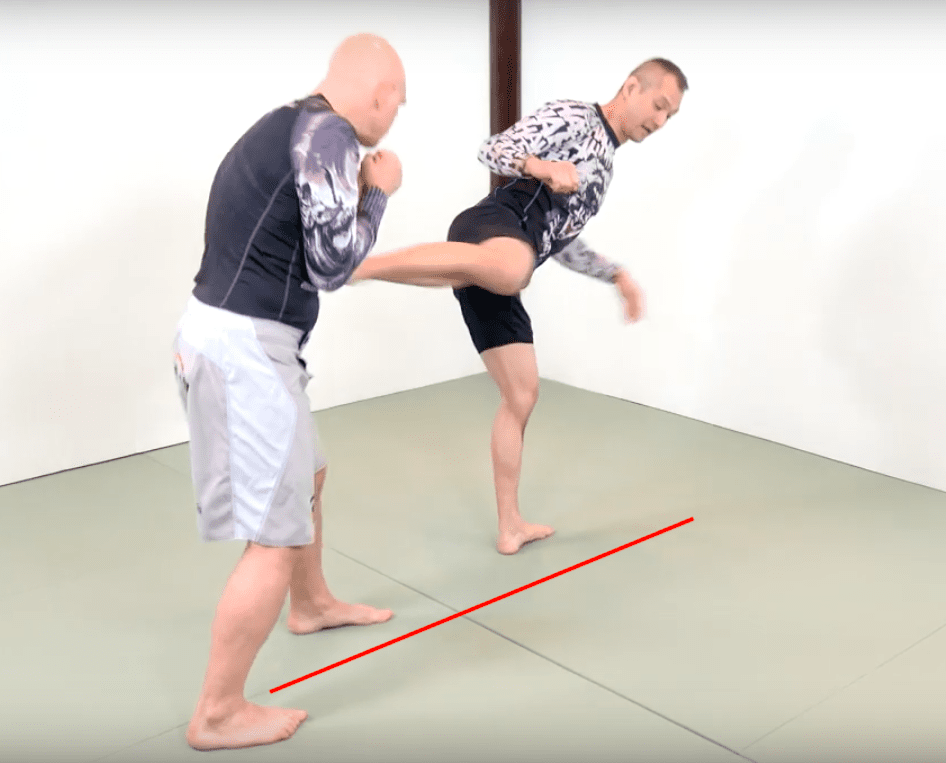
In contrast to a typical mistake where we don’t step across the line and then we wind up missing the target.
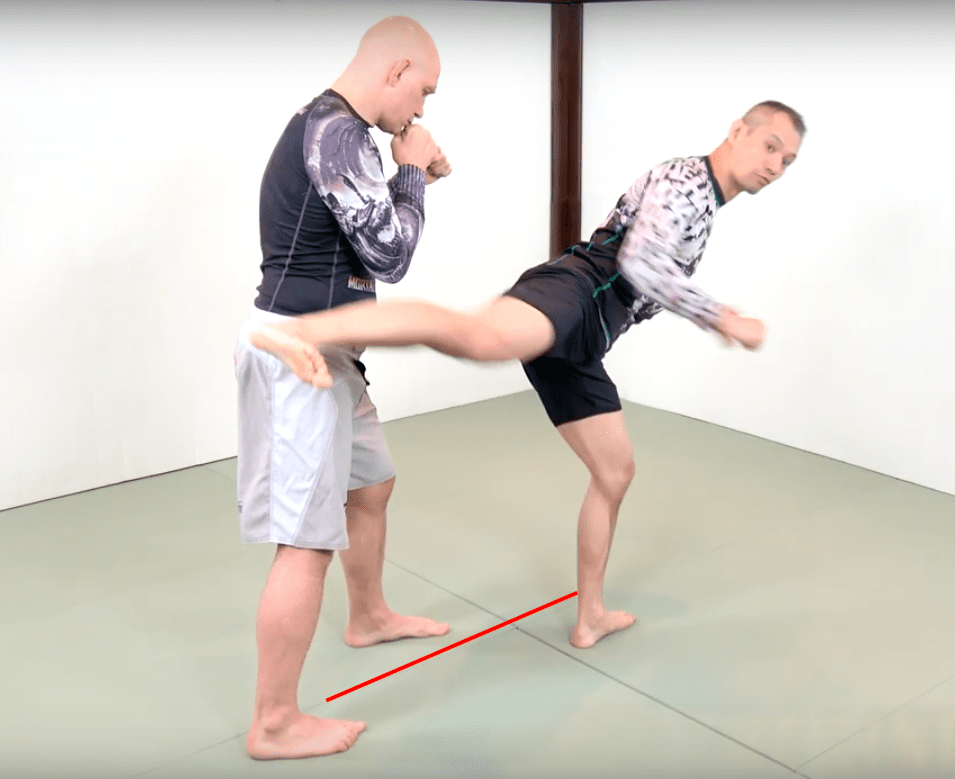
In particular order, a successful Spinning Back Kick is:
- Step
- Turn
- Kick
Unquestionably, at full speed execution, all of these steps are done all at once in a fluid, dynamic manner. Here I’m holding focus mitts for my student, Ian Popoff. Note how his step and turn are virtually simultaneous.
Similarly, with the Side Kick, you need to lift your knee for your Spinning Back Kick. By lifting your knee, you’re ensuring that you have maximum power for your Spinning Back Kick.
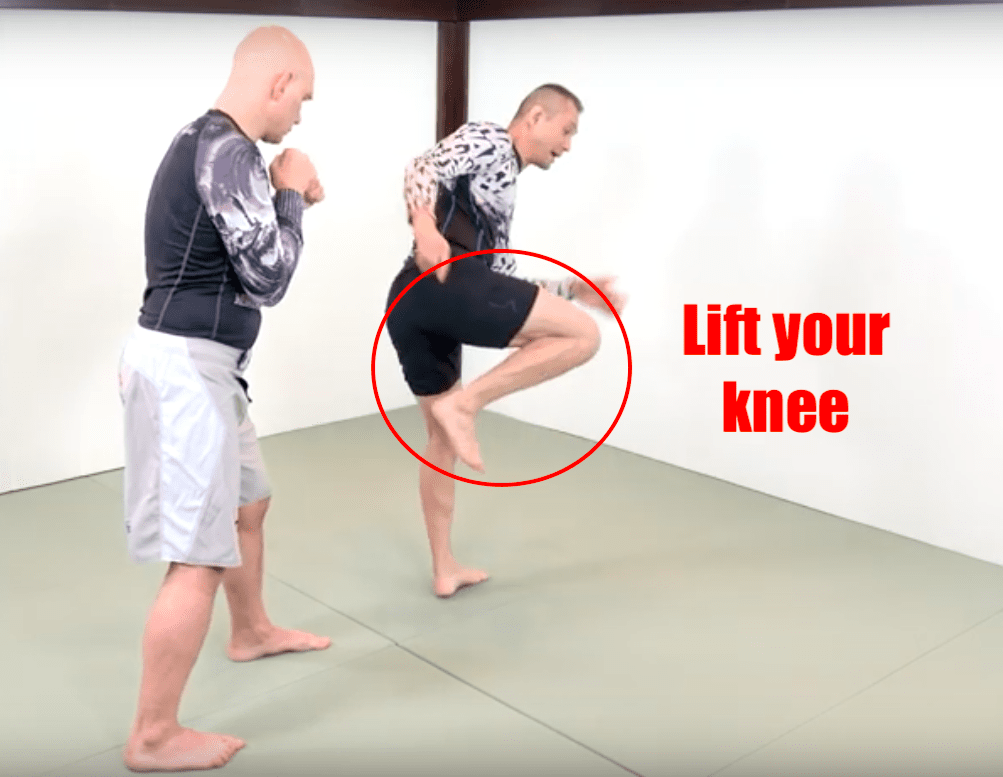
Previously, with the Side Kick, I mentioned how you need to fully extend your leg and that you need to kick into the floor as well as kick into your target. This is precisely the same for the Back Kick. In addition to fully extending your leg, you also want to focus on chambering your knee for the kick. These two details can be combined to make for a really cool drill.
Watch 👀 the video 📺 below! ⬇️
In conclusion, this video below breaks down all the details for the Spinning Back Kick along with some common mistakes you should avoid.
Points to remember:
- Failing to cross the line
- Not aiming with your planted foot
- Not tapping your knee
Conclusion
Kickboxing is super fun way to get in shape and make some new friends all while learning an exhilarating new skill 😊
This concludes our reference guide on the Kickboxing Basics. Use these basic techniques to put together some cool combinations and set ups.
Check out my Precision Kickboxing Masterclass video instructional series!
The A to Z system for learning Kickboxing as fast as possible 😃
You’ll learn:
- Detailed fundamentals
- Advanced combinations
- Punching and Kicking defense
- Effective counter attacks
- Solo and partner drills
- How to use training equipment
- Safe Sparring progressions
- Winning fight strategies
You can watch this anywhere on your phone, tablet or laptop.

Click here to check out my Precision Kickboxing Masterclass! 😃

